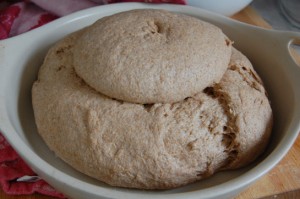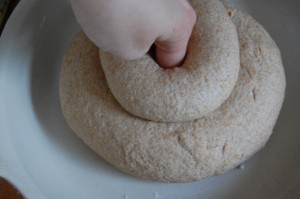“Red current jelly was served with the cold mutton, and potato salad and pickled cabbage, afterwards there was a deep apple pie with lots of Devonshire cream. In the centre of the dinner-table, just below the cruet stand, stood an enormous loaf of bread. Mr. Harding, the baker, cooked one for Father every Saturday. It was four loaves baked in one so that it did not get as stale as four small loaves would have. It was made cottage-loaf-shape–two storeys high with a dimple in the top.” The Book of Small by Emily Carr.
Cottage loaves are a traditional British shaped loaf, perhaps going back to Roman times. One small ball of dough is placed on top of a larger one and it’s supposed to resemble a cottage. Traditionally they are made with a plain white or whole wheat dough. I’ve made mine with my everyday sourdough, with just a few changes. It’s really just a fun way to shape the dough as it will taste the same as when made in the loaf pan.
I’ve always liked to experiment with different shapes with bread. There is something so fun about taking the same dough and shaping it into different forms. As a busy mother, I haven’t had as much time to do so the last few years, but the above quote from Emily Carr’s biographical work, The Book of Small, inspired me to give it a try. Besides letting it over rise, I think it was a success! I think it would be a fun shaped bread to serve when company is over or with a big pot of stew. And I always love trying “traditional” things, even bread loaf shapes.
The book is very interesting. I hadn’t heard of it before, but my mother owned it and I started reading it one day and got hooked. Emily Carr is best known for her art, but this little book of sketches from her childhood is absolutely fascinating. Her childhood took place in a very interesting time frame ( Victorian) in a very interesting place (Victoria, B.C.) when it was still a wild and untamed land. My husband and I have visited Victoria, and it’s absolutely beautiful, so I especially thought it interested to read what it was like in her childhood.
I felt a special connection to Emily as a child as she reminded me of myself as a child quite a bit. We were both happy to play by ourselves in our little dream worlds, especially if animals were nearby. We also were both very affected by pain experienced by animals. The trauma Emily felt over dogs being abused or shot, was the same that I felt over teenagers abusing animals for “fun”. Yet, there is one difference I hope to have with Emily. There is a thread of melancholy that winds itself around her stories. One sometimes gets the impression that she remembers more of the sad things of her childhood then the happy things. I want to look back at my life and see the happy things at least just as much as the sad, if not more. All in all though, an enjoyable read and a very interesting view into an Victorian childhood on the edge of “civilization”.
- 1 cup of recently fed sourdough starter
1 cup of water
1 1/2 teaspoon unrefined salt
2-4 tablespoons honey
3-5 cups of whole wheat flour
1) In a medium sized bowl, combine the starter, water, salt and honey. Using a sturdy wooden spoon, stir in flour until you can no longer stir. Turn out onto the counter and knead in enough flour to make a firm dough. Knead for about 5 minutes.
2) Grease a bowl with plenty of rise room with a little bit of olive oil and place your dough inside it. Turn the dough upside down so that there is now oil on the top of the dough. Cover and let rise in a warm place for 3-12 hours, or until double in size.
3) It’s time to shape the dough! Divide the dough into one larger piece (about 2/3’s of the dough) and a smaller piece (about 1/3 of the dough.)

Shape both into a nice round shape (you can use a kind of kneading motion to help you) and place the small ball on top of the large.

Using two fingers, press down through the small ball into the large ball. This helps both give it the customary shape and helps the dough stick together.
4) Place on a greased sheet and cover. Let rise until just about double. My dough rose incredible fast. In an hour and a half, it looked like this!

See how it’s “breaking” a bit on the side? That is showing that it’s over risen. It didn’t have as nice of a shape because of it, but that’s okay!
In a 375 degree oven cook for 45 minutes, or until nicely browned and it sounds hollow when knocked on the bottom side. Let cool and slice and serve with butter.
Latest posts by KimiHarris (see all)
- 2 Ingredient Peppermint Bark - December 21, 2022
- Herbal Hibiscus Lemonade (Keto, THM) - March 16, 2022
- Creamy Curry Red Lentil Soup - December 8, 2021



How fun! One of my newest favorite sourdough books (found at a consignment store for about $1!) features tons of different shapes that I never even considered . . . it does make baking more fun, doesn’t it?
Looks beautiful!
Best,
Sarah
PS – Did you get my e-mail? If not, this is the correct one, linked to my profile . . .
Wow that looks *delicious*! I have yet to try making sourdough bread…I have made a couple loaves of regular homemade bread though and soon I will be ready to give sourdough a whirl!
How would you store that so it doesn’t go stale? I guess it doesn’t fit inside a Ziploc?
If you cut it in half, you can store it in Ziploc. We served most of the first night and then it fit fine. 🙂
What is unrefined salt?
Salt that hasn’t been bleached and dried at high temperatures or the trace minerals removed. Examples: Real Salt, Celtic Sea Salt, etc. 🙂
I missed out on the Book of Small — I shall have to find a copy and read it. Your post is delightful and inspiring. Thanks. I always look forward to your literary food posts!
Gorgeous food. Enjoy it very much. Nothing like the smell of baking bread. 🙂
Gave your blog an award: http://lessofmimi.wordpress.com/2010/08/06/versatile-blogger-award/
Thanks! That’s so sweet. 🙂
I like to cook with whole grains but have a hard time finding recipes for such. This past week, I tried tweaking a No-Knead Bread recipe with the goal of incorporating sourdough, wheat, and rye. It had great flavor but was much heavier than I had anticipated. This cottage loaf of yours looks wonderful, and I am excited to give it a try! Also, I love to read and have been glad to see your posts including something about books you have enjoyed. Thanks!
I find that is I use a really active sourdough starter that it really helps keep my sourdough products light. But sometimes you still end up with those more dense loaves. 🙂
I though you did gluten free. Do you find that you are able to tolerate the fermented grains such as sourdough?
Hey Michelle,
I have done a gluten free diet before (for about two months), but since my body doesn’t seem to mind gluten, we went back to it. Though it is interesting that sourdough really helps predigest the protein, including the gluten, in bread, especially when it’s soaked for a long period of time. So even though this bread is not “gluten free”, I think for me it’s an easier to digest bread. 🙂
I can’t wait to try this but am having the worst time with my sourdough starter. Do you have any suggestions of where or how I can start one? I’ve been trying the one suggested in Nourishing Traditions but it keeps failing on me.
i’m wanting to make my own starter too… would love to hear your tips!
I’m looking forward to trying to use sourdough for more things, and thought about using the starter from NT–do you recommend that? Would you mind sharing your starter recipe, or do you buy a starter?
Thanks!
Your recipe doesn’t specify soaked flour. Are you using pre-sprouted flour maybe?
Lori, the sourdough rising time is the “soaking period”. You can use sprouted flour for this recipe, but sourdough is supposed to be a very effective way to reduce phytic acid and other anti-nutrients. 🙂
If I soak my flour first, how much water should I soak it in, since the recipe only calls for one cup total? Thank you so much!